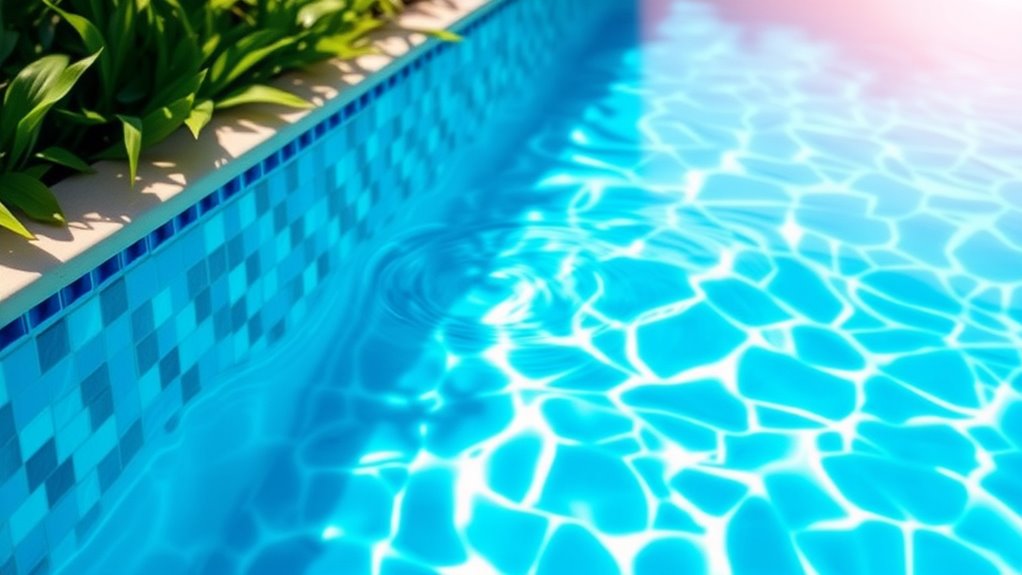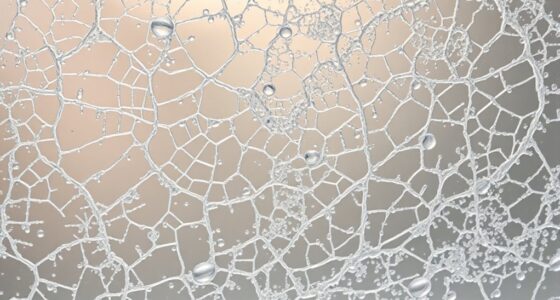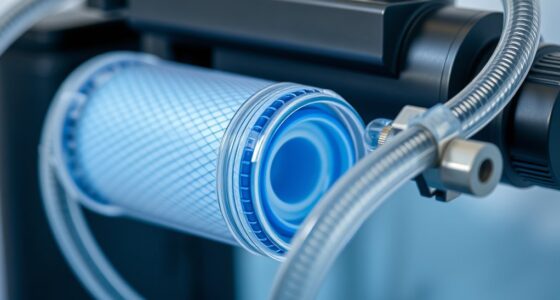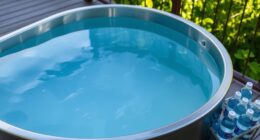To keep your small pool or tub crystal clear, regularly clean and replace filters, and check water chemistry often. Test pH and sanitizer levels, adjusting with the right chemicals to prevent cloudiness and algae growth. Remove debris daily by skimming, and give surfaces a thorough clean weekly. Proper placement in shaded areas helps reduce algae. For more tips on maintaining pristine water, explore easy strategies tailored to your small pool or tub setup.
Key Takeaways
- Regularly clean and replace filters to ensure efficient water circulation and debris removal.
- Test and adjust water chemistry, keeping pH between 7.2 and 7.6 for clarity and safety.
- Skim surface daily and clean sides and bottom to prevent organic buildup and cloudiness.
- Shock the water periodically to eliminate organic contaminants and maintain sparkling clarity.
- Position the pool or tub in shaded areas to reduce algae growth and decrease maintenance needs.
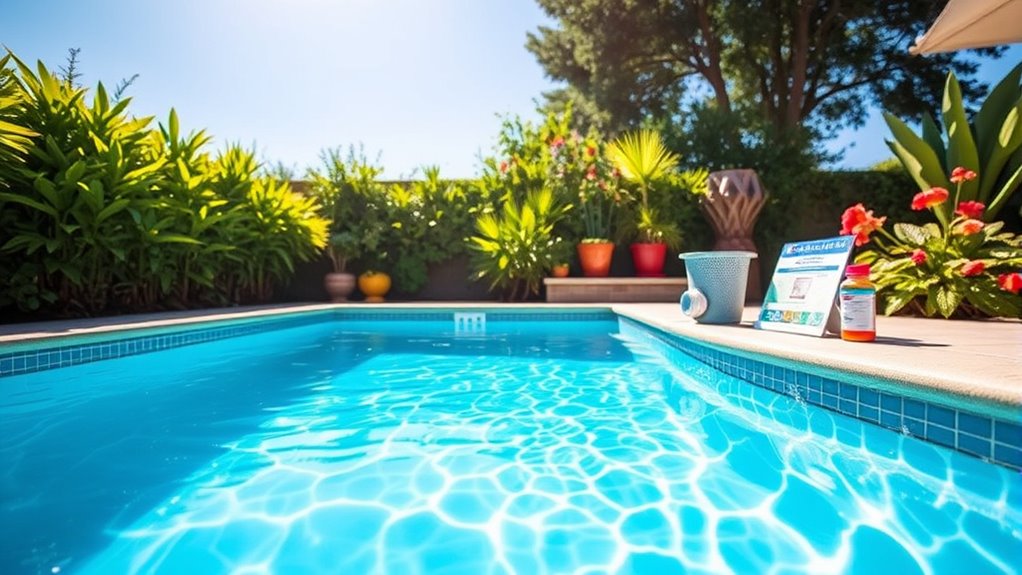
Keeping small pools and tubs crystal-clear can be a challenge, but with the right maintenance, it’s easily achievable. One of the most important aspects is proper filtration maintenance. Your filtration system acts as the pool’s or tub’s first line of defense against dirt, debris, and algae. Regularly cleaning or replacing filters ensures it functions efficiently, preventing particles from floating around and clouding the water. A clogged or dirty filter won’t do its job properly, so check it weekly, especially after heavy use or storms. When cleaning filters, follow the manufacturer’s instructions to avoid damage, and consider upgrading to a high-quality filter if you notice persistent cloudiness or debris buildup. Remember, a well-maintained filter keeps the water circulating, trapping contaminants before they can cause issues.
Regularly clean or replace filters to keep your pool or tub water crystal-clear and contaminant-free.
Along with filtration, maintaining proper water chemistry is vital. Your water’s pH, alkalinity, and sanitizer levels directly influence clarity and safety. Test your water regularly using reliable test strips or a testing kit, aiming for a pH between 7.2 and 7.6. If the pH drifts out of this range, it can cause cloudiness, scaling, or corrosion of equipment. Adjust the pH with appropriate chemicals—pH increasers or decreasers—based on test results. Equally important is maintaining proper sanitizer levels, such as chlorine or bromine, to kill bacteria and algae that can turn water cloudy. Use a consistent dosing schedule, and never forget to shock the water periodically to eliminate organic contaminants. Balancing water chemistry isn’t a one-time task; it requires ongoing attention to keep the water sparkling and safe.
In addition to filtration and water chemistry, rinsing out your pool or tub regularly helps remove debris before it dissolves or causes buildup. Skim leaves and insects daily, and clean the sides and bottom with a brush or vacuum suitable for small pools or tubs. This prevents organic material from decomposing and contributing to cloudiness. Also, consider the placement of your pool or tub—placing it in a shaded area can reduce algae growth, making maintenance easier and less frequent. Proper filtration maintenance is essential for preventing cloudiness and ensuring your water stays clear.
Ultimately, consistent filtration maintenance paired with vigilant water chemistry management will keep your small pool or tub looking clear and inviting. It might take some effort, but establishing a routine makes the process straightforward. With clean filters, balanced chemicals, and regular cleaning, your water stays crystal-clear, ready for relaxing dips whenever you want.
Frequently Asked Questions
How Often Should I Change the Water in My Small Pool or Tub?
You should change the water in your small pool or tub every 1 to 2 weeks, depending on usage. Regular water testing helps you maintain proper pH balance and detect any imbalances early. If the water looks cloudy or has an odor, it’s time for a change. Keeping up with these checks guarantees your water stays clear and safe, making your pool or tub more enjoyable and hygienic.
Can Natural Remedies Replace Chemical Treatments for Water Clarity?
Sure, you can try natural remedies, but don’t count on them to replace chemical treatments entirely. They’re often just a band-aid rather than the whole kit and caboodle. Organic alternatives and mineral-based solutions may help improve water clarity, but you’ll likely need a balanced approach with proper filtration and occasional chemicals. Think of it as putting a fresh coat of paint—use the right tools for the best results.
What Are the Best Filters for Small Pools or Tubs?
The best filters for small pools or tubs are cartridge filters and small sand filters, as they suit limited spaces and are easy to maintain. You should prioritize filter types with high pump efficiency to guarantee effective water circulation and clarity. Look for models that match your pool size and offer strong flow rates. Properly choosing and maintaining these filters keeps your water crystal clear and safe for use.
How Do I Prevent Algae Growth in Small Pools?
To prevent algae growth, you should focus on effective filtration techniques and algae prevention strategies. Make sure your filter runs regularly to keep the water moving and debris out. Use algaecides as needed and maintain proper chlorine or sanitizer levels. Regularly skim the surface and clean the filter. By keeping the water clean and circulating, you minimize algae growth, ensuring your small pool stays clear and inviting.
Is It Safe to Swim Immediately After Adding Chemicals?
Imagine sparkling water, inviting you for a dip, but don’t jump in right after adding chemicals. For chemical safety, wait at least 15-30 minutes, ensuring the chemicals circulate and disperse. Following swimming guidelines, check the water’s clarity and test the pH before swimming. Rushing in can cause skin irritation or chemical reactions. Always prioritize safety, and enjoy your invigorating swim once the water is properly balanced.
Conclusion
Keeping your small pool or tub crystal clear is like tending a delicate garden—you need consistent care and attention. Regularly check and balance your chemicals, clean filters, and skim debris to prevent cloudiness. Think of your water as a mirror reflecting your dedication; with a little effort, it’ll stay sparkling and inviting. By following these simple tips, you’ll transform your small oasis into a pristine retreat that invites relaxation and enjoyment every time.
